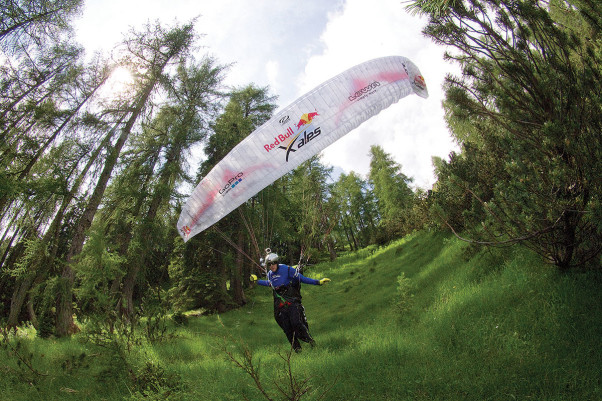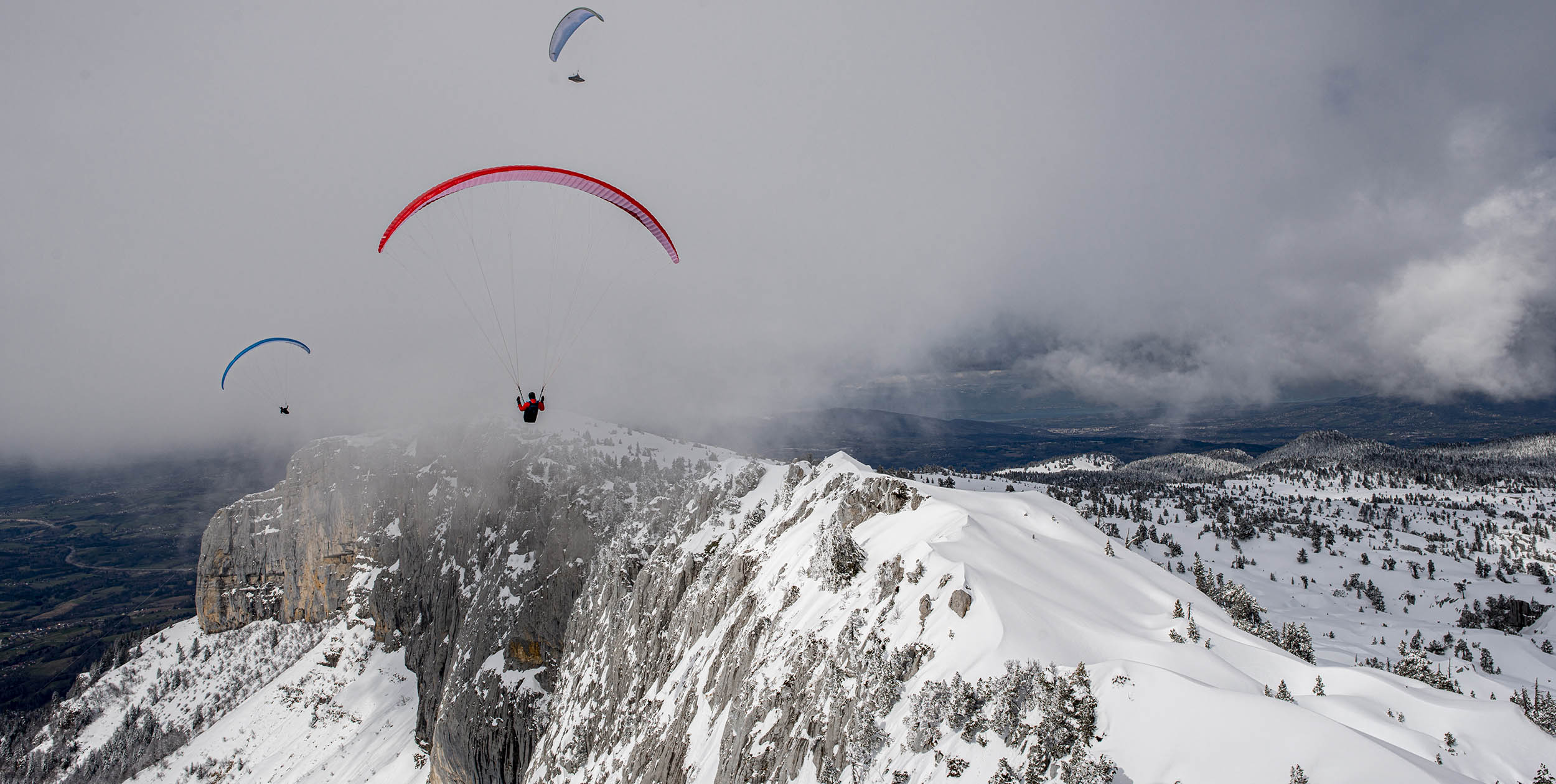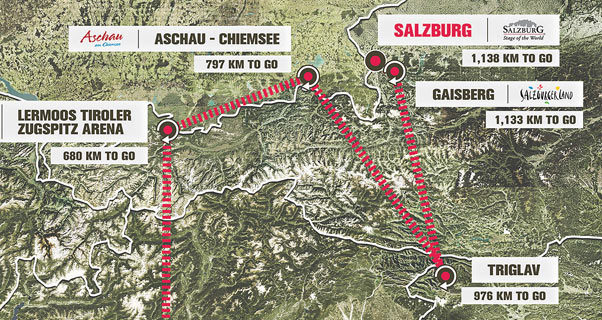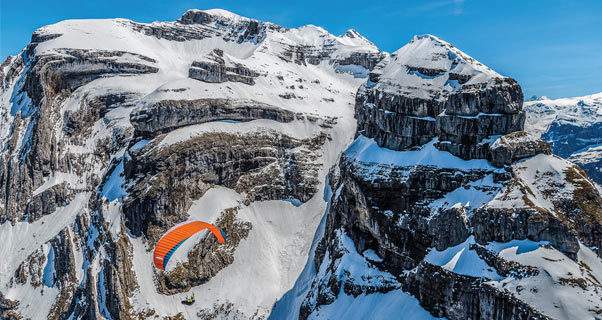
SQUEEZING IN. Chrigel Maurer launches from a tight spot during the 2013 X-Alps. Photo: Vitek Ludvik/Red Bull Content Pool
Jon Chambers has been flying for over 20 years and has competed in the Red Bull X-Alps twice. He lives in Geneva and flies in the Alps where he enjoys being a Tandem Dad to his kids. He is the author of Hanging in There, a book about the X-Alps. His regular column in issue 161 was on flying from remote mountain launches.
There is nothing particularly special about most of the official launches in the Alps. In fact, the one unifying criteria they all fulfill is the fact that they all have good access, either by road or via a cable car, which has nothing to do with flying! So in this age of lightweight gear, hike-and fly and X-Alps what should you look out for when thinking of launching somewhere other than an official club launch?
Firstly, a general rule – the higher you go the more options you will find. This is primarily because higher will take you above the tree line and so finding a slope that meets all your criteria will be easy. So if you are planning a hike-and-fly trip in the high Alps the take-offs will be easy to come by. In the pre-Alps, and particularly in the southern Italian Alps it can be more challenging to find a good launch spot as the mountainsides are forested to a much higher altitude relative to the valley floor. In these cases you need to look for clearings, fire breaks, areas of high altitude pasture or plan for a very long walk.
To pick the right spot you first need to consider the surroundings and the airflow. Obviously you want somewhere the air is flowing up the slope, but you need to take a broader look around and make sure it is not curling around a spur or worse, the back flow from rotor (I made that mistake in the 2011 X-Alps and I do not recommend it!).
The space you need to get one glider into the air is actually very small, so you will find it surprising how easy it is to find the space you need. Ideally you want the wing laid out on a not too steep slope that won’t snag the lines and a slope that then drops off to ensure you get easily into the air. But you don’t always find the perfect site, so here are some tips from my experience.
Steep or Shallow
You can launch from surprisingly shallow slopes, especially if there is next to no wind. A good modern glider will have a glide of 10:1 so all you need is a slightly sloping field – just watch out for any obstacles in front, and be prepared to run hard! On the other hand, very steep slopes can be tricky – you will need quite some wind to prevent the wing sliding down to you, and even then you may need help to hold it. As soon as you pull the wing up from the ground you’ll be airborne so make sure you’ve checked it well for knots first.
Rough surfaces
Of course, grass is best but in case you can’t find such an option there are a few tricks you can try. The main reason for looking for a good surface is to not snag your lines as you pull the wing up. So it does not matter too much where the wing is as long as the lines aren’t going to catch. For example, you can lay the wing carefully on low bushes and have the lines effectively strung across to you in your harness – this way you only need a few metres of clear ground. On scree and rocks, take the time to get the glider perfectly laid out and then check the lines and lay them carefully in a straight line back to the harness. Lines get caught because they pull sideways as the wing inflates, but if they are close to being perfectly aligned from the harness to the wing there is less chance that they catch as you pull the wing up. If it doesn’t come up straight away, get out the harness and get it set up perfectly again.
Finally, a trick I used once to launch from a slope covered in that nasty heather that catches the lines is to sort out the wing somewhere else and walk to the launch spot with the glider in a perfect mushroom. You’ll need a bit of breeze up the slope for this – but lay the wing down in the mushroom and carefully put all the lines in one single ‘rope’ between your balled-up wing and you. Remember you’ve already checked and detangled them. Now take a few firm steps backwards and pull the balled up wing into the air using the A’s as normal – it will unfurl once it is in the air and the lines will be off the ground by that point, hence preventing any snagging.
Wind not right
As long as you are sure there is no danger, taking off with a crosswind or even a light downslope wind is quite possible. For a downslope wind you’ll need to find a pretty good stretch for a hard concerted run. If it doesn’t work you need space to abort safely, so don’t try this in a tight spot. For cross winds, if it is light you can do the same as for the downslope, just run diagonally, slightly into the wind at the start of the run before straightening up down the hill. If it is a stronger crosswind, then pick the glider up into wind and run across the slope into the wind before leaning downslope to turn and run off the hill.
Many of us are rightfully nervous of launching somewhere other than an official launch. Like any skill, once you practise a bit you get used to what to look for and it soon becomes second nature. Before you know it you’ll be launching from all sorts of places! Respect local rules, especially in national parks and on private land, be sensible and stay safe and the mountains will quickly become your playground.
If you enjoyed this sample article, perhaps you’d consider subscribing? A subscription is also a perfect gift for any pilot! Cross Country is a reader-supported international publication
Subscribe and receive 10 issue in print or digital, and we’ll also send you a Cross Country Wallet pre-loaded with 10 Euros to spend at xcshop.com







